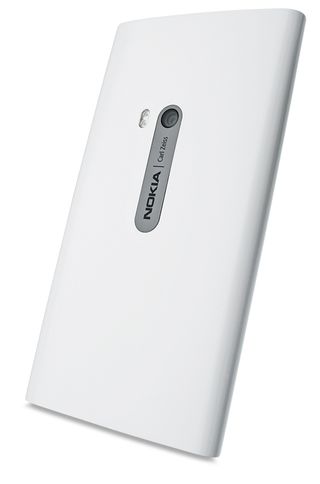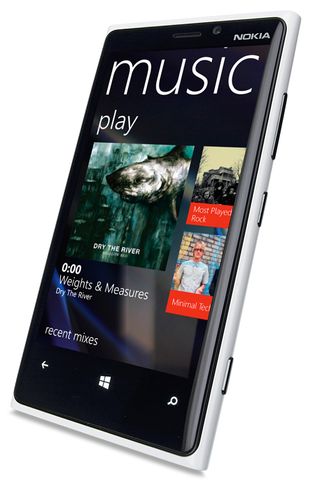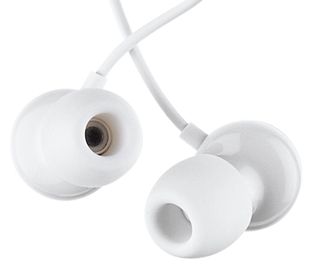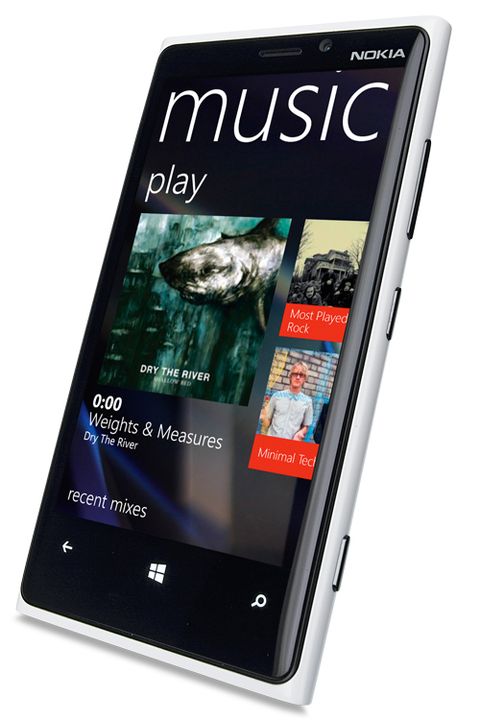There is a lot riding on the Nokia Lumia 920. Firstly, it’s the flagship phone from Nokia, a company that desperately wants – and needs – to become more relevant in the high-end smartphone market. A 1280 x 768 resolution makes the 332 pixels per inch (PPI) rating one of the highest around.
Unlike key competitors you won’t find a quad-core processor, the Lumia 920 settling for a 1.5Ghz dual-core with 1GB of RAM, with Nokia believing that quad-core processors are as yet unnecessary for today’s smartphone demands.
Clearly the company believes a good quality camera is of more importance, the Lumia 920 being treated to a 8.7MP/1080p/30fps camera with the company’s respected PureView technology and a Carl Zeiss lens. There’s a lower spec front-facing camera as you’d expect.
It’s arguably the showcase handset for Windows Phone 8, the new mobile OS from Microsoft – and boy do they want to a piece of the landscape currently dominated by Android and iOS.
Tech specs

So it’s no surprise that the Lumia 920 measures up very nicely indeed when it comes to the vital smartphone statistics. A 4.5in IPS TFT screen means the Lumia 920’s display is just shy of big boys such as the Nexus 4 (4.7in) and Samsung Galaxy S3 (4.8in), though of course notably bigger than the iPhone 5’s Retina screen (4in).
You'll have to make do with 32GB capacity as there’s no SD card slot, nor can you remove the battery, so fingers crossed the fairly standard 2000 mAh integrated battery does a decent job.
Build and design

The Lumia 920 is a hulking great chunk of smartphone, which coupled with a range of four colours – bright yellow and red, or more predictable white and black – makes for a handset that will certainly make its presence felt. And it’ll do the same in your pocket: weighing in at 185g, it’s over 65% heavier than the 112g iPhone 5.
The curved rear casing – also apparent on HTC’s Windows Phone 8 device, the HTC 8X – makes for a thicker phone but it feels good in the hand. As with the larger screen-sized phones, the extra heft of the Lumia 920 is worth feeling for yourself before you take the plunge as it won’t suit everyone.
While first impressions of the unibody build are positive, over time we notice not only some flex on the top side of our review sample but also a rattling of the overall casing when the phone vibrates. This seems to be a wider issue according to reports online, so it’s worth keeping an eye on.
There are three buttons on the right hand edge. One for the camera, a screen on/off button and a volume rocker.
The position of the screen on/off button in the middle of the handset meant we found ourselves occasionally pressing it by accident, and the buttons seemed a little loose, too.
And talking of loose, you'll want a firm grip on the phone itself as the casing doesn't offer much in the way of grip. All told, we can’t help but place a question mark against the Lumia 920 build quality.
Interface

The Windows Phone 8 OS (operating system) looks very different to Android and iOS. Anyone familiar with either operating system will need a little while to familiarise themselves but conversely, coming to the OS fresh, it’s ultimately a simpler, more intuitive layout.
Essentially, there are two screens of action: the main home screen full of ‘live tiles’ and, one swipe from right to left, an alphabetical list of all your menus and apps.
The live tiles are like widgets on the Android OS, constantly updating with new information, from pictures to mail and messages. You can choose your size of tile for each app that you want on your home screen and then rearrange them, Tetris-style, however you choose. You can’t however rename them, so multiple mailboxes will have the same icon.
It’s neat and works well provided you don’t want too many apps at your fingertips. If you do, you’ll have to manage your screen real estate closely – or deal with searching through a long list of apps on screen two.
There are no hard buttons here, just three key touch controls at the foot of the screen – a back button, home button and search, powered by Microsoft’s Bing.
Navigation is fast and smooth, but not flawless. You can multitask between open apps by holding the back button but it's still easy to get lost and, most notably, find yourself wondering ‘where’s that music coming from and how do I stop it?’.
The lack of a screen rotation lock seems an over sight, too. It seems generally that the simpler you keep your phone experience, the more comfortable you’ll find the Windows Phone 8 OS experience.
Apps
On the subject of apps, there’s good news and bad news. Of course, the Windows Phone OS means you will need Windows Phone apps. The Windows Phone Store is the place to go and you’ll find apps, games and music, plus a ‘Nokia Collection’ area for Nokia apps.
There’s no option for buying movies or TV shows however. And, though Nokia is bullish about its app offering, it simply isn’t as thorough for now, with BBC iPlayer, Sonos and Spotify notable absentees, though unofficial versions of popular apps are popping up.
On the plus side, Nokia Maps are good and there’s a Nokia Drive navigation app, which despite being in Beta mode functioned perfectly well. Lastly, there’s Nokia Music, a completely free streaming music service (from a limited library) or the ability to pay for individual tracks (from a more exhaustive library) with prices.
Pre-loaded on the Lumia 920 you’ll find full versions of Microsoft Office’s Word, Excel and PowerPoint programmes, which will appeal to many, and easy syncing of your finished work with email applications or Microsoft’s cloud storage service, SkyDrive.
The Windows Phone Store has the same horizontal scrolling design as you’ll see throughout the majority of Windows Phone apps, which looks smart and brings a welcome uniformity to the app experience.
Nokia, like HTC, has put its own twist on the Windows Phone experience. Nokia City Lens allows you to hold up the screen and see nearby shops, restaurants and more super-imposed on top. It works reasonably well, though doesn’t dig as deep as Siri or Google Now.
Web browsing
The Nokia Lumia 920 web browsing experience comes, of course, courtesy of Internet Explorer. The most obvious change for most people will be the browser bar at the bottom rather than top. Tabbed browsing, favourites (aka bookmarks), back and refresh buttons are all here.
It’s a lightning fast browsing experience, and pages respond quickly to pinch and zoom functions. Text is sharp and white web pages are clean and crisp, though flash video, such as found on the BBC website, won’t play.
The default Bing search results don’t seem as exhaustive nor simply as useful to us, so we suggest diving in to ‘settings’ from within Internet Explorer and then navigating to ‘advanced settings’ and ‘default search provider’ and switching to the all seeing eye that is Google. But the choice is yours, naturally.
Video quality
The Lumia 920 has a 4.5in IPS TFT screen with a 1280 x 768 resolution, delivering 332 pixels per inch. Not bad on paper, but how does it perform? For starters: there’s no easy way to buy videos on the Lumia, so you’ll have to make do with your own video content. MP4, H.264 and WMV video files are all accepted.
On a more positive note, if you're an Xbox owner, there's plenty of integration between phone and Xbox, from viewing your online profile on your phone, to pushing content from one device to another using the free SmartGlass app.
And the Lumia 920 stands up well when it comes to picture quality. Edges are well-defined making for a sharp picture, while colours are subtle and colourful if not as dynamic and bright as some rivals.
Fast motion isn't a problem and contrast levels are good thanks to deep blacks. It's fairly weighty in the hand but otherwise as a portable video device it's easy to recommend.
Sound quality
When it comes to music and sound quality, the Lumia 920 certainly has plenty to offer. The 'music+video' icon is your port of call for all your music (and video, not surprisingly) and there are essentially three key ways to access content: your own content dragged and dropped into your 'collection' as normal; by adding apps – Rdio is here alongside podcast options; or by using Nokia Music, which is where it gets interesting.
This is essentialy Nokia's own streaming service, and it's completely free. Again, the interface takes a little getting used to but essentially you can stream tracks, and then pay to download them if you choose, or you can listen to 'mix radio' stations of content based on genre.
There's a wide selection, from charts to bestsellers, classical to minimal techno, and it's all free and available to download for offline listening. If you're a new music fan and don't mind a hands-off music experience – not least as there's no option to rewind/fast forward tracks – it's great.
The sound quality isn't quite as impressive as the selection of music. There's decent punch and dynamics, and reasonable detail, but a slightly splashy and occasionally bright edge to treble notes lets the side down. A little more organisation is needed when really pushed.
As for the standard in-ear headphones, the white buds look quite cool, keeping a low profile with no Nokia branding. They're comfortable but sit fairly deep in the ears, and the sound is thin and low on detail.
On the subject of sound it's worth nothing that the overall volume of your music corresponds to any other tones, too. So if you're listening to music at a fairly loud level, then remove your headphones and type a text, then the key tones will be nice and loud. Individual volume settings would have been handy here.
The Lumia 920 has DLNA and Bluetooth streaming capabilities on board so you can stream audio and video to connected wireless speakers and other devices. It's Bluetooth 4.0 certified, but there's no sign of the superior aptX codec.
Camera
Nokia has made a big push when it comes to the quality of the cameras on the company’s phones. While the Lumia 920 can’t match Nokia’s PureView 808's whopping 41MP camera, it does have Carl Zeiss optics and an 8.7MP lens, as well as plenty of picture customisation options.
It’s certainly possible to get excellent results – but we didn’t find the quality of our pictures as consistent as on other handsets. Detailed, three-dimensional and sharp when we got it right, getting images in focus seemed trickier on the Lumia 920 than on others in our experience.
Call quality is clear and consistent and we had no issues with call drop-out or network coverage. On the subject of which, while we reviewed the standard Lumia 920, a Lumia 920 LTE with 4G compatability is available exclusively on EE, the UK's first 4G network (alongside a Lumia 820 LTE).
A 2000 mAh battery is fairly par for the course at the premium end of the smartphone market and it's no more than sufficient when it comes to comparative battery performance. A day's heavy usage will see the battery drain, as per the likes of the iPhone 5 and the Galaxy S3.
However, it's not as easy to keep an eye on what's guzzling your juice as on said rivals, though there is a 'battery saver' mode, which essentially turns off key features such as wi-fi when you're down to the last 30% of power. Wireless charging is available straight out of the box, although Nokia's official charging pad is an expensive optional extra, at £45.
Verdict
The Nokia Lumia 920 looks and feels like no other smartphone on the market. This in itself is an achievement worthy of praise.
The WP8 experience is fresh, different and a qualified success in our minds, which alongside some worthwhile software adds-on unique to Nokia and solid all-round phone performance, makes the Nokia Lumia 920 a decent alternative.

